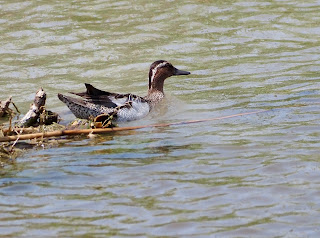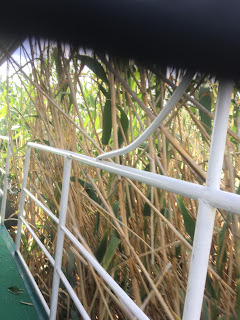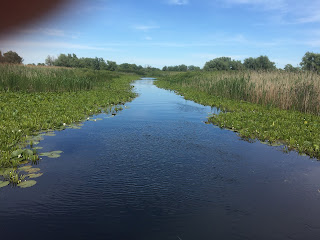Tuesday 6th June 2023: Danube Delta Day 3
I enjoyed another early morning from the boat roof, this time setting up with my scope to scan the reedbeds across the river. There was a slight mistiness to the air before the sun gained the strength to burn this away and clear the views. It was fascinating to watch a singing Hoopoe perched on the tallest dead branch of a tree, nodding his head at the start of each burst of song, like a wooden balance toy that bends back and forth. I had never observed this behaviour before. In the shrubs behind the boat a Lesser Whitethroat was active, gathering food for his nest. A pair of displaying Rollers, demonstrating how they got their name, was another memorable experience not previously encountered. A Purple Heron stood motionless on the water’s edge, and small unidentifiable warblers flitted at the base of the reeds, possibly Savi’s or more likely Reed Warblers. A Reed Bunting balanced on the swaying seed heads was visible through the scope. A flock of Black-winged Stilts flew overhead, long legs trailing in a distinctive silhouette. And all before breakfast, a superb yet peaceful start to the day.
This morning we again took the small boat travelling down scenic, gentle waterways watching the usual herons and ducks going about their delay lives, until our approaching boat disturbed them, and sent them scurrying to the backwaters or safety of the reeds. Reed Bunting, Penduline Tits and Cuckoos were also spotted as we drifted past. The Cuckoos are certainly thriving in the delta, with the less familiar bubbling call frequently heard.
 |
| Cuckoo |
We passed a log, with an upright shape standing vertically. It looked owl-like, but it’s always easy to mistake these things, so I raised my binoculars with little expectation, but in fact it looked fluffy, and possibly a hint of a closed eye as we passed. “An owl” I cried. Bernie claimed it was a log and since the boat did not reverse back, no definitive conclusion was reached. Simon sprang to my defence, supporting the fluffiness observation and we both looked carefully on the return for an owl shaped log, but did not find one, lending further support to my case. However, Bernie was again dismissive, saying we’d just forgotten where on the river it was and must have missed it. I remain convinced I saw an owl, most likely to be Long-eared Owl based on the species list. So not on the official list, but it provided a good source of banter across the week!
Soon we arrived at our drop off point at Letea and ‘walked the plank’ to dry land, fortunately with a home made handrail to help us balance as we crossed. Here some beautiful blue pools nestled in the grassy meadows, a magnet for birds. White- winged Terns swooped noisily overhead but soon disappeared. Stilts, Avocets and a couple of Egrets were all feeding here. A colony of Sand Martins nesting in the bank by one pool circled the water, and Bee-eaters buzzed around the wires. A splendid Yellow Wagtail rested on a tall weed allowing everyone to study its head markings in the telescope. We were informed this was of the Romanian race ‘dombrowskii’.
We walked along a raised dyke, overlooking terrain reminiscent of the African savannah, with herds of horses, cattle and goats grazing the landscape. A Red-footed falcon sat in a tree, then put on a tremendous display overhead. Hobbies and kestrels were also present. Collared Pratincoles were seen in flight then distantly resting on the mudbank. Luckily they eventually relocated and we all had very good scope views. On one side of the dyke, with marshy pools, a Ruddy Shelduck swam into view briefly and four juvenile Spoonbills, (with all black bills and no ‘custard’ tip) moved around the pools. A group of Black-tailed Godwits were probing for food. On the saltmarsh to our left, Kentish Plover were seen with a group of Little Stint, very active as they foraged the water margins. Several leggy Avocet swished their bills for food and amongst the roosting gulls we were delighted to find another four Pallas Gulls. Finally at this location, a family of Shelduck with very endearing babies swam on ‘the magical pool’, which our guide informed us was not man made but appeared suddenly, hence its name. An interesting homemade bus, similar to trailers pulled by tractors on farm visits in the UK took us on a bumpy ride back to our boat. From here we passed a busy Sand Martin colony, and also a bank of empty holes. Had the colony relocated for some reason we wondered? A Sedge warbler sang as we departed, and we slowed to observe a beautiful woven Penduline nest. A pair of Garganey also showed well before their nerves got the better of them and they took flight.
 |
| Garganey |
 |
| Shelduck |
 |
| Penduline Tit nest |
 |
| Collared Pratincole |
After lunch, we headed downstream on the hotel boat, noting several Hobbies and Common Terns on the journey. Later we transferred back to the small boat and had a mesmerising trip along narrow reed-choked channels, backwaters and pools full of water lilies, vast willows draping their branches across the water and wide open expanses. In such varied habitats we encountered a rich variety of birds, White-tailed Eagles perched in towering trees, an elusive Grey-headed Woodpecker, teasingly skirting up a branch to give brief, camouflaged glimpse, Black terns heading downstream, then waves of Whiskered Terns circling a corner of the river with an abundance of insects.Squacco Herons loitered at the waters’ edges until spooked by our passing boat. As we moved slowly through the water Common Redstart, Chaffinch, Blackcap and Reed warbler were all seen in the riverside vegetation.
 |
| White-tailed Eagle |






Comments